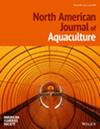指导鲑鱼养殖场采样的网络应用程序,以更精确地估计海虱数量
IF 1.3
4区 农林科学
Q3 FISHERIES
引用次数: 0
摘要
目标通过主动监测有效管理鲑鱼养殖场的海虱对估计海虱数量至关重要,但由于需要有效的取样计划,因此具有挑战性。为了解决这个问题,我们开发了一种应用软件,该软件考虑了虫害水平、养殖场结构和管理规程,提高了海虱数量估算采样策略的精确性。方法在标准公式不充分的复杂研究中,基于模拟的方法对于估算合适的样本大小非常有价值。我们介绍了 FishSampling,这是一种基于网络的开放式应用程序,可根据特定情况和目标确定精确的样本大小。结果该模型纳入了海虱丰度、养殖场围栏数量、围栏间潜在的聚类效应以及所需的置信度等因素。该应用程序中的模拟结果提供了实用建议,说明如何在不同程度的假定集群效应下决定抽样的鱼和围栏数量。结论该方法可用于整个鲑鱼养殖业,以改进海虱丰度估计的抽样策略,并平衡监控成本与健康目标。本文章由计算机程序翻译,如有差异,请以英文原文为准。
Web‐based application to guide sampling on salmon farms for more precise estimation of sea louse abundance
ObjectiveEfficiently managing sea lice on salmon farms through active surveillance, crucial for lice abundance estimation, is challenging due to the need for effective sampling schemes. To address this, we developed an application that considers infestation levels, farm structure, and management protocols, enhancing the precision of sampling strategies for sea louse abundance estimation.MethodsSimulation‐based methods are valuable for estimating suitable sample sizes in complex studies where standard formulae are inadequate. We introduce FishSampling , an open Web‐based application tailored to determine precise sample sizes for specific scenarios and objectives.ResultThe model incorporates factors such as sea lice abundance, farm pen numbers, potential clustering effects among these pens, and the desired confidence level. Simulation outcomes within this application provide practical advice on how to decide on the number of fish and pens to sample, under varying levels of assumed clustering.ConclusionThis approach can be used across the salmon aquaculture sector to improve sampling strategies for sea lice abundance estimation and balance surveillance costs against health objectives.
求助全文
通过发布文献求助,成功后即可免费获取论文全文。
去求助
来源期刊
CiteScore
2.50
自引率
0.00%
发文量
46
审稿时长
18-36 weeks
期刊介绍:
The North American Journal of Aquaculture publishes papers on new research and practical experience in all areas of intensive and extensive fish culture. Topics include broodstock selection and spawning, nutrition and feeding, health and water quality, facilities and production technology, and the management of ponds, pens, and raceways.
The journal will consider papers dealing with ways to improve the husbandry of any aquatic species—marine or freshwater, vertebrate or invertebrate—raised for commercial, scientific, recreational, enhancement, or restoration purposes that may be of interest to practitioners in North America. Its scope includes both basic and applied science, but applied scientific endeavors—including practical experiences, descriptive studies, and other nontraditional, but pertinent works—are emphasized.

 求助内容:
求助内容: 应助结果提醒方式:
应助结果提醒方式:


